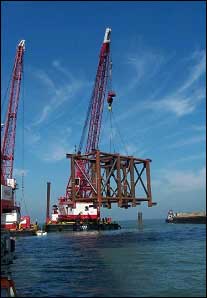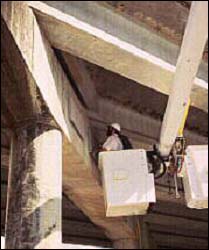















Successes in Stewardship: March 2005 |
|---|

|
Federal Highway Administration
March 2005
Improving Environmental Performance in Construction and Maintenance

In recent years, State Departments of Transportation (DOTs) have been placing new emphasis on environmental performance related to construction, operations, and maintenance activities. In the past, DOTs mainly focused on environmental compliance, but agencies across the country are now taking a more holistic approach to meeting environmental stewardship goals. Incorporating stewardship priorities into construction and maintenance helps DOTs achieve continuous improvement in environmental performance.
DOTs that are interested in this emerging approach don't have to "reinvent the wheel" and develop their practices from scratch — agencies can learn from each other's experiences. Thanks to a project conducted through the National Cooperative Highway Research Program (NCHRP), a new tool can quickly get useful resources into the hands of DOT staff. This work was sponsored by the American Association of State Highway and Transportation Officials (AASHTO) in cooperation with the Federal Highway Administration (FHWA).
The project report compiles more than 7,000 innovative practices in highway construction and maintenance, as well as policy, organizational, and management approaches to improving environmental performance. Instead of spending scarce resources to develop new programs, agencies can "adapt and adopt" selected practices into their own operations. From "Bird and Bat Roosts in Bridges" to "Road and Roadside Dirt and Debris," this encyclopedic document describes a broad range of sample practices and provides links to examples, design drawings, or more detailed technical guidance or procedures.
Environmental Stewardship Practices, Procedures, and Policies for Highway Construction and Maintenance (NCHRP Project 25-25 (04)) is a joint effort of AASHTO's Standing Committee on the Environment and two subcommittees of the Standing Committee on Highways — Subcommittee on Construction and Subcommittee on Maintenance.
Gary McVoy, Director of Maintenance for New York State DOT and member of the Standing Committee on the Environment, described the impetus behind the project: "field staff know stewardship is the right thing to do, but lack training and information to do it. Environmental Stewardship Practices, Procedures, and Policies for Highway Construction and Maintenance will give these people the tools they need to do the job they want to do."
|
Why Focus on Construction and Maintenance?
Construction and maintenance activities encompass all areas of a highway system. So highway improvements-even seemingly minor ones-can have far-reaching impacts.
|
The project team reviewed thousands of best management practices and DOT standards and manuals to create this substantial document, which includes practices from 48 states and nations around the world, including Canada and Australia. The report is designed to be user-friendly, with a detailed table of contents and thousands of links to more information. DOTs should be able to easily extract and re-use the relevant information.
A benefit for transportation agencies is that many of the report's featured practices not only preserve the environment; they also help keep costs down. Reduced salt usage is a good example of such a dual-purpose practice. Many maintenance departments have long held a philosophy of over salting "to be on the safe side." PennDOT's Smart Salting program addresses this issue with regular training that helps staff make better decisions about how much salt is actually needed. While keeping the safety of the motoring public at the forefront, the Smart Salting program raises staff awareness of application rates, the location of streams and wetlands, and other relevant factors. This enables them to apply just enough salt without over salting. In addition to saving on materials, PennDOT saves on cleanup costs after the winter season.
Other practices that promote a healthy environment as well as healthy finances include:

An Oregon Wedge daytime bat roost is installed in Texas. The roost is an inexpensive method for retrofitting bridges and culverts to provide a home for bats, many of which are not endangered species, but are also beneficial to farmers. |
Some states are already using the report. Utah DOT's Chief Environmental Engineer, Brent Jensen, is encouraging his staff to use the report as both an assessment tool to measure UDOT's progress in relation to successful practices across the country and as an on-the-shelf reference and training tool. Mr. Jensen assigned chapters to his staff for review and found that, while UDOT is using most of the recommended practices or something similar already, the compendium offers many ideas to further advance environmental stewardship. UDOT will begin rolling out new or improved practices in spring and summer 2005 to evaluate effectiveness locally.
The report is available at the AASHTO Center for Environmental Excellence website http://environment.transportation.org. The Center, which operates in partnership with the FHWA, works to "promote environmental excellence in the efficient delivery of transportation projects." AASHTO has committed to ongoing implementation activities in support of the project, which will likely include mechanisms for peer-to-peer technical assistance and for incorporating feedback and keeping the report current. The implementation team met in January during the 2005 Annual Meeting of the Transportation Research Board to discuss awareness activities and next steps. In the meantime, AASHTO's Subcommittee on Construction hopes to identify a handful of practices to be featured at the Subcommittee's Annual Meeting in August.
Transportation agencies that would like to begin implementing new or improved stewardship practices can get additional assistance from the Center for Environmental Excellence by contacting the Center's Director, Shannon Eggleston.
|
Look What's New!
|
Contact InformationShannon Eggleston, DirectorCenter for Environmental Excellence AASHTO 444 North Capital Street, NW Suite 249 Washington, DC 20001 Email: seggleston@aashto.org Phone: (202) 624-5800 |
|
